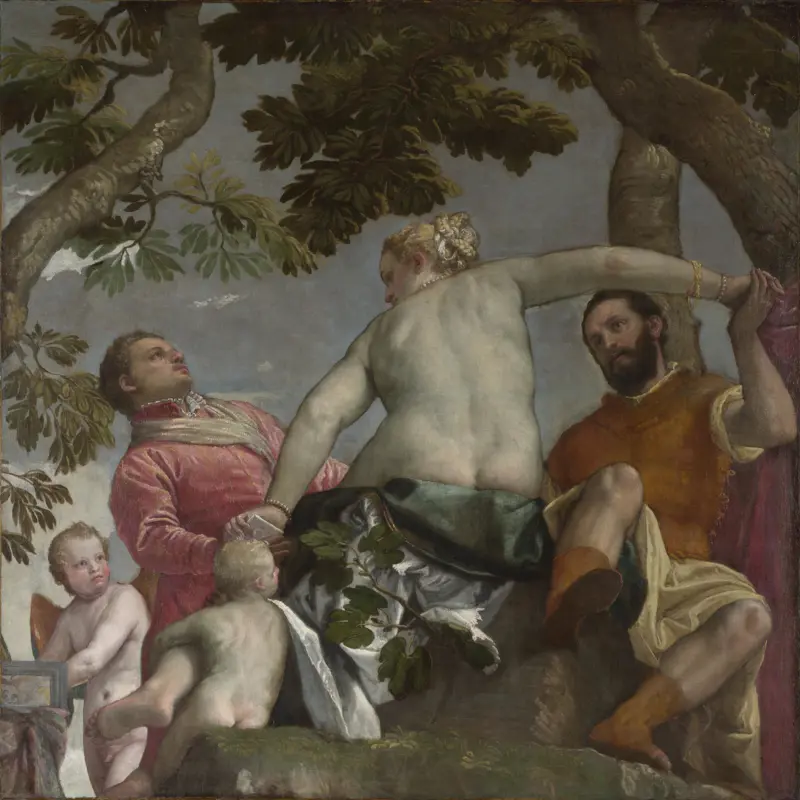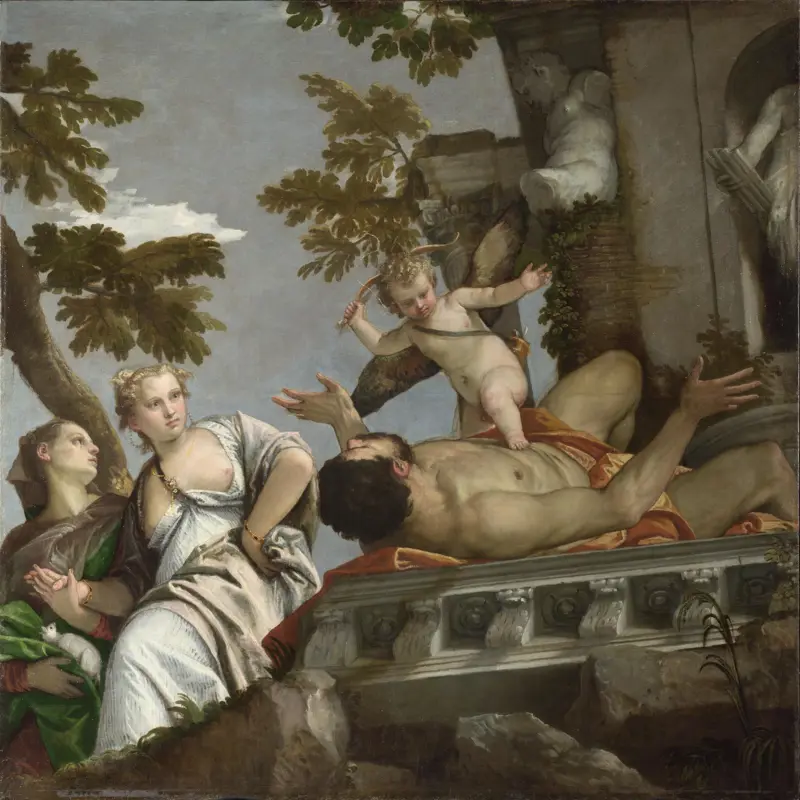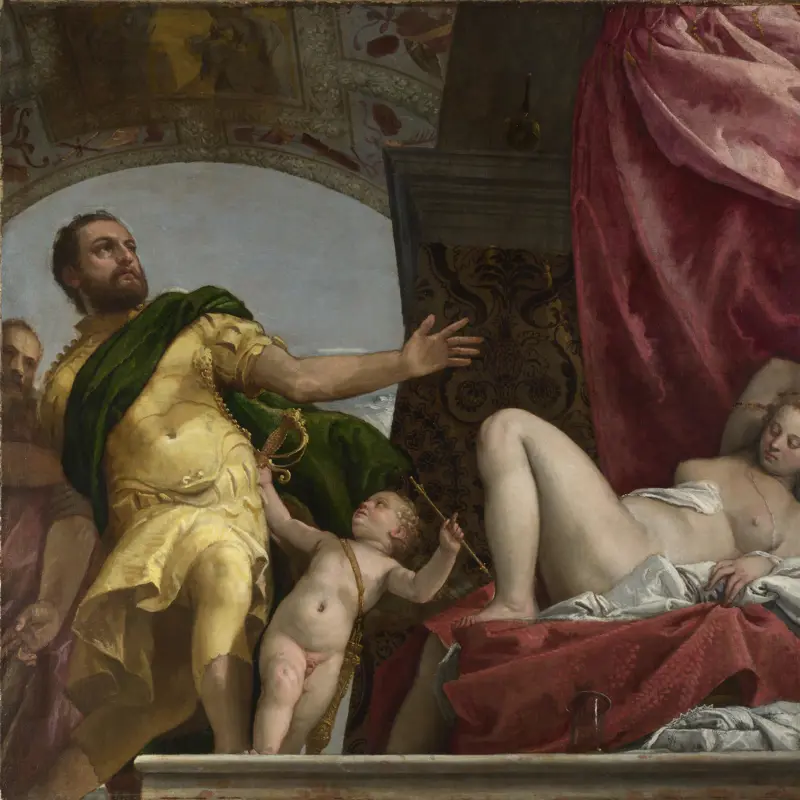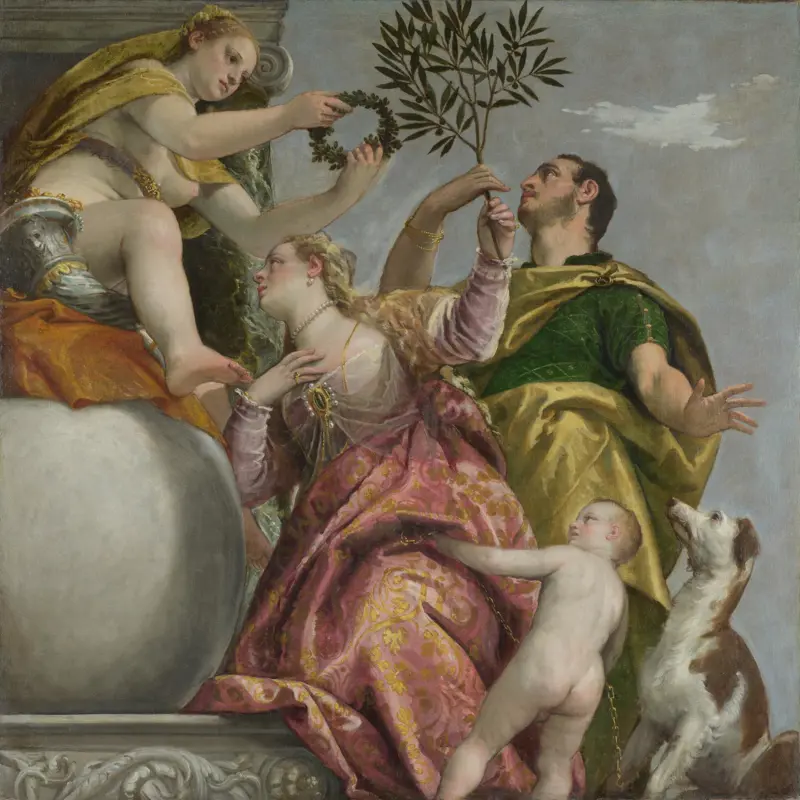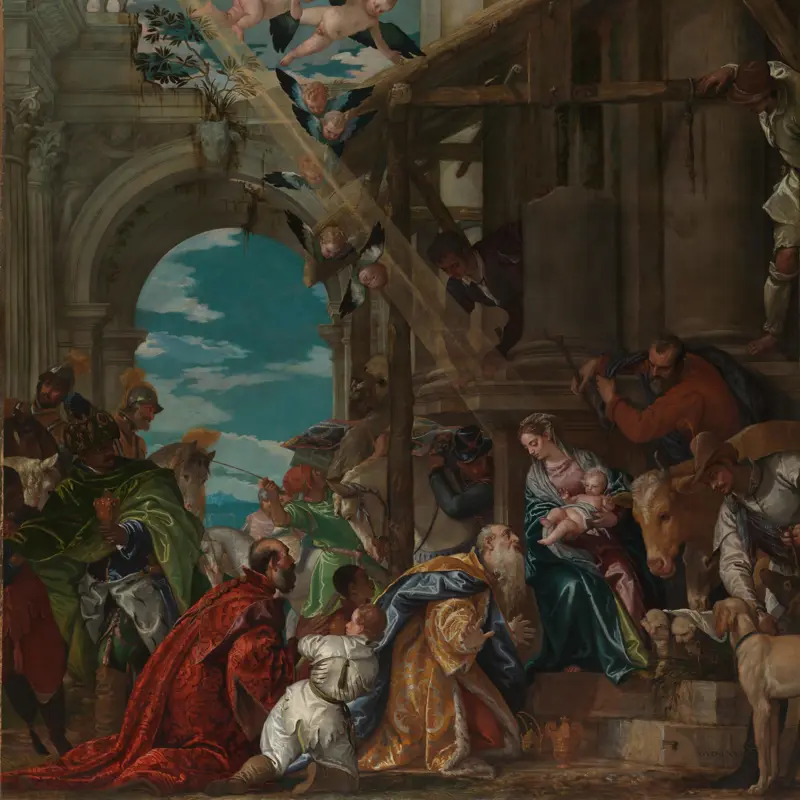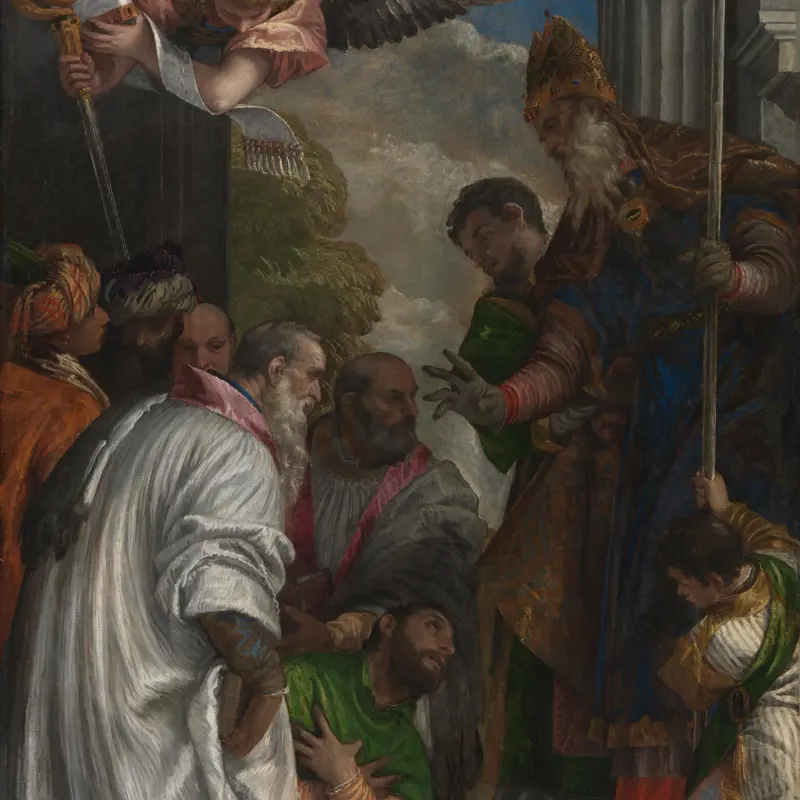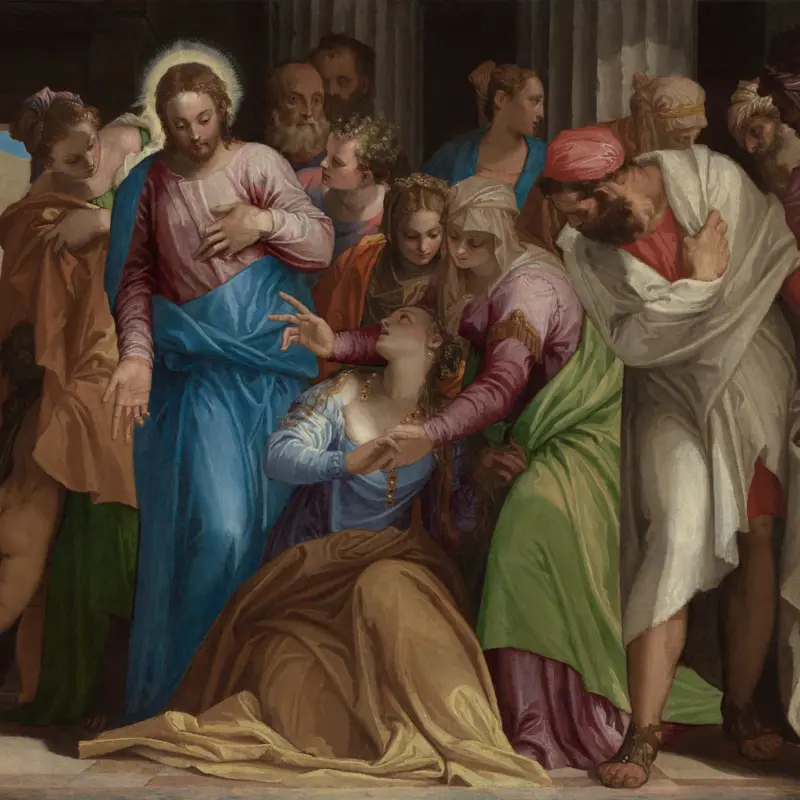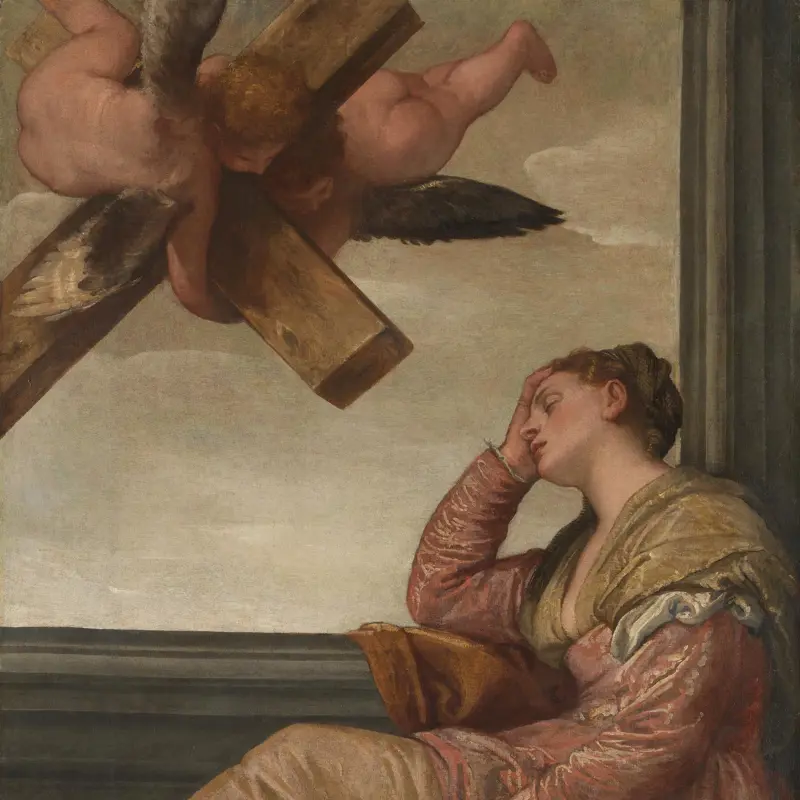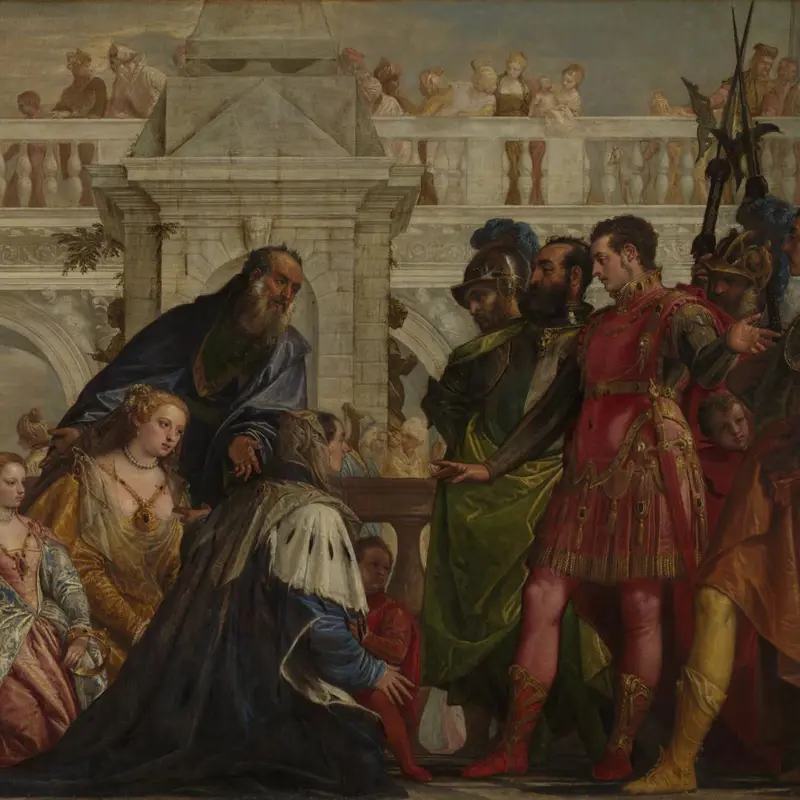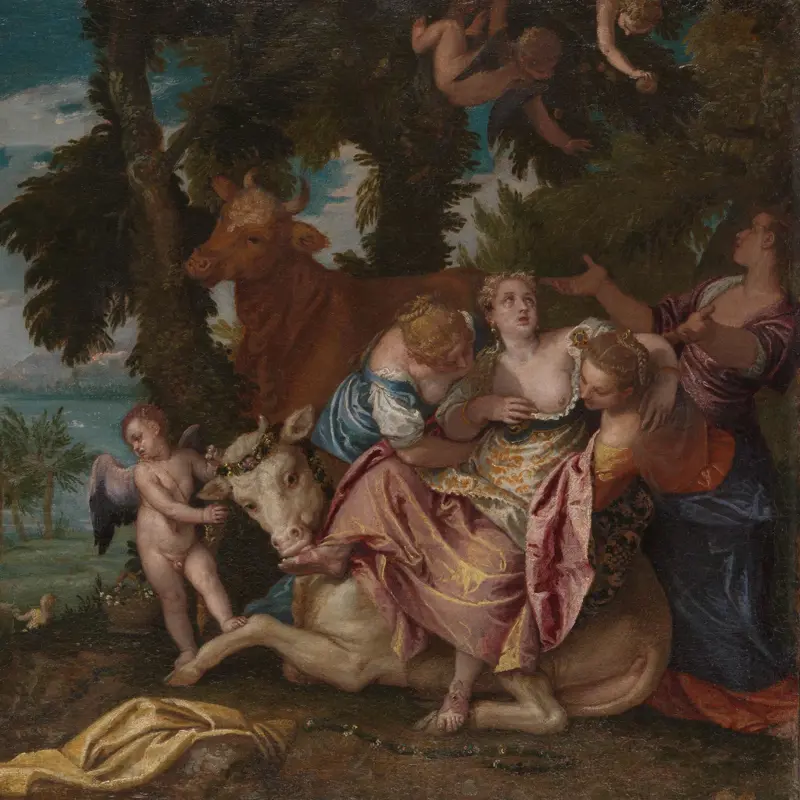Paolo Veronese, 'Unfaithfulness', about 1575
About the work
Overview
This is one of a series of four paintings by Veronese that concern the trials and rewards of love, although their precise meanings remain unclear. The compositions are designed to be seen from below, so we know the pictures were intended for a ceiling or a series of ceilings.
A naked woman with her back to the viewer sits between two clothed men, exchanging a note with one of them. It is inscribed with red letters which appear to spell either ‘che / uno possede’, meaning ‘which one person possesses’, or Ch.. / mi. p(ossede) meaning ‘which/who possesses me’ – the dots indicating illegible letters. The inscription may mean ‘she who has one man (should be satisfied)’ or possibly ‘she who has one lover (will always want another)’.
Even if this picture represents indecision in courtship rather than marital deceit, there is nothing within it to express disapproval.
Key facts
Details
- Full title
- Unfaithfulness
- Artist
- Paolo Veronese
- Artist dates
- 1528 - 1588
- Part of the series
- Four Allegories of Love
- Date made
- about 1575
- Medium and support
- oil on canvas
- Dimensions
- 189.9 × 189.9 cm
- Acquisition credit
- Bought, 1890
- Inventory number
- NG1318
- Location
- Room 9
- Collection
- Main Collection
- Previous owners
- Frame
- 19th-century English Frame
Provenance
Additional information
Text extracted from the ‘Provenance’ section of the catalogue entry in Nicholas Penny, ‘National Gallery Catalogues: The Sixteenth Century Italian Paintings’, vol. 2, ‘Venice 1540–1600’, London 2008; for further information, see the full catalogue entry.
Exhibition history
-
2014Veronese: Magnificence in Renaissance VeniceThe National Gallery (London)19 March 2014 - 15 June 2014
-
2014Paolo VeronesePalazzo della Gran Guardia5 July 2014 - 5 October 2014
Bibliography
-
1727L.D. de Saint-Gelais, Description des tableaux du Palais Royal: Avec la vie des peintres à la tête de leurs ouvrages: Dédiée à Monseigneur le duc d'Orleans, premier prince du sang, Paris 1727
-
1742P.-J. Mariette, Recueil d'estampes d'après les plus beaux Tableaux et d'après les plus beaux dessins qui sont en France, dans le Cabinet du Roi, dans celui de Monseigneur le duc d'Orléans et dans d'autres cabinets, Paris 1742
-
1808L.A. de Bonafons et al., Galerie du Palais Royal: Gravée d'après les tableaux des différentes ecoles, Paris 1808
-
1854G.F. Waagen, Treasures of Art in Great Britain: Being and Account of the Chief Collections of Paintings, Drawings, Sculptures, Illuminated Mss. […], vol. 2, trans. E. Eastlake, London 1854
-
1877F.G. Stephens, On the Pictures at Cobham Hall: An Address Delivered in the Picture Gallery, July 27th, 1876, London 1877
-
1897J.O. Granberg, La galerie de tableaux de la reine Christine de Suède, Stockholm 1897
-
1923C.J. Holmes, Old Masters and Modern Art: The National Gallery, Italian Schools, London 1923
-
1927P.H. Osmond, Paolo Veronese: His Career and Work, London 1927
-
1929C.H.C. Baker, National Gallery, Trafalgar Square: Catalogue, London 1929
-
1934G. Fiocco, Paolo Veronese, Rome 1934
-
1947P. Hendy, An Exhibition of Cleaned Pictures of 1947: (1936-1947), London 1947
-
1959Gould, Cecil, National Gallery Catalogues: The Sixteenth Century Venetian School, London 1959
-
1967E. Wind, Pagan Mysteries in the Renaissance, London 1967
-
1968G. Piovene and R. Marini, L'opera completa del Veronese, Milan 1968
-
1969J. Plesters, 'A Preliminary Note on the Incidence of Discolouration of Smalt in Oil Media', Studies in Conservation, XIV/2, 1969, pp. 62-74
-
1970A. Braham, 'Veronese's Allegories of Love', The Burlington Magazine, CXXII/805, 1970, pp. 205-12
-
1975C. Gould, Delaroche and Gautier: Gautier's Views on the 'Execution of Lady Jane Grey' and on other Compositions by Delaroche, London 1975
-
1975J. Bordeaux, 'A Sheet of Studies for Veronese's Four Allegories of Love', The Burlington Magazine, CXVII/870, 1975, pp. 600-5
-
1978M. Royalton-Kisch, 'A New Arrangement for Veronese's Allegories in the National Gallery', The Burlington Magazine, CXX/900, 1978, pp. 158-63
-
1981J. Mills and R. White, 'Analyses of Paint Media', National Gallery Technical Bulletin, V, 1981, pp. 66-7
-
1983E. Goodman-Soellner, 'The Poetic Iconography of Veronese's Cycle of Love', Artibus et historiae, IV/7, 1983, pp. 19-28
-
1983J. Mills and R. White, 'Analyses of Paint Media', National Gallery Technical Bulletin, VII, 1983, pp. 65-7
-
1984R. Cocke, Veronese's Drawings: A Catalogue Raisonné, London 1984
-
1984D. Sutton, 'Aspects of British Collecting, III.XIII: The Orléans Collection', Apollo, CXIX/267, 1984, pp. 357-72
-
1987Gould, Cecil, National Gallery Catalogues: The Sixteenth Century Italian Schools, London 1987
-
1988F. Folliot, A. Forray-Carlier and F. Mardrus, Le Palais Royal (exh. cat. Musée Carnavalet, 9 May - 4 September 1988), Paris 1988
-
1988W.R. Rearick, The Art of Paolo Veronese, 1528-1588 (exh. cat. National Gallery of Art, Washington, 13 November 1988 - 20 February 1989), Washington 1988
-
1993E.M. Pozzolo, 'Il lauro di Laura e delle maritate venetiane', Mitteilungen des Kunsthistorischen Institutes in Florenz, XXXVII, 1993, pp. 257-91
-
1993F.R. Pesenti, 'Sul colore in Paolo Veronese', Ricerche di storia dell'arte, LI, 1993, pp. 5-19
-
1993R. White and J. Pilc, 'Analyses of Paint Media', National Gallery Technical Bulletin, XIV, 1993, pp. 86-94
-
1994R. Barrington, 'Copyist, Connoisseur, Collector: Charles Fairfax Murray (1849-1919)', Apollo, CXL/393, 1994, pp. 15-21
-
1995T. Pignatti and F. Pedrocco, Veronese, Milan 1995
-
1995N. Penny and M. Spring, 'Veronese's Paintings in the National Gallery, Technique and Materials: Part I', National Gallery Technical Bulletin, XVI, 1995, pp. 4-29
-
1996N. Penny, A. Roy and M. Spring, 'Veronese's Paintings in the National Gallery, Technique and Materials: Part II', National Gallery Technical Bulletin, XVII, 1996, pp. 32-55
-
1998F. Pedrocco, Veronese, Florence 1998
-
2001
C. Baker and T. Henry, The National Gallery: Complete Illustrated Catalogue, London 2001
-
2001D. Jaffé, 'New thoughts on Van Dyck's Italian sketchbook', Burlington Magazine, CXLIII/1183, October 2001, pp. 614-24
-
2001V. Biermann, 'The Virtue of a King and the Desire of a Woman?: Mythological Representations in the Collection of Queen Christina', Art History, XXIV/2, 2001, pp. 213-30
-
2003M. Olausson et al., Cristina di Svezia: Le collezioni reali (exh. cat. Fondazione Memmo, 31 October 2003 - 15 January 2004), Rome 2003
-
2005A. Bayer, 'North of the Apennines: Sixteenth-Century Italian Paintings in Venice and the Veneto: The Triumvirate: Titian, Veronese, and Tintoretto', Metropolitan Museum of Art Bulletin, LXIII/1, 2005, pp. 6-35
-
2008Penny, Nicholas, National Gallery Catalogues: The Sixteenth Century Italian Paintings, 2, Venice, 1540-1600, London 2008
Frame
This is one of four symmetrical Sansovino-style frames made in England in 1895. Crafted in pinewood and oil-gilt, it features outset square corners decorated with rusticated scrolls and festoons made from composition. At the centres are convex ‘mirrors’.
The four frames were created to historicise Veronese’s Four Allegories of Love. This frame may have been produced by the framemaker Reginald Dolman. By 1932 the frame was fitted with a glazing door and had received new gilding. The frames are cited in Robert Benson’s 1913 report, Notes on Frames.
About this record
If you know more about this work or have spotted an error, please contact us. Please note that exhibition histories are listed from 2009 onwards. Bibliographies may not be complete; more comprehensive information is available in the National Gallery Library.
Images
About the series: Four Allegories of Love

Overview
These four paintings by Veronese concern the trials and rewards of love, although their precise meanings remain unclear and have been much debated. The titles are not original and were given to the paintings in 1727. The scenes are not necessarily meant to go in any particular order.
The compositions are designed to be seen from below, so we know the paintings were intended for a ceiling or a series of ceilings. The lower parts of the compositions seem to have been cut, and in several cases the feet of the figures are not visible. These features are disconcerting when the pictures are hung on a wall. The composition of each painting forms a strong diagonal, which would help relate the paintings to each other on a ceiling. We do not know who commissioned them, but it may have been a wealthy patron in Venice or one of the Holy Roman Emperors.

